 |
| Dendera as it appears in the 1830s, artwork of David Roberts |
Next it is about an hour and 15 minute drive to Dendera, less than 40 miles north of Luxor. (Tourists often take a day trip from Luxor to visit here.)
This temple is dedicated to Hathor, goddess of love and pleasure and consort to the god Horus. The site is a very ancient place of healing although the temple itself is "new" in terms of Egyptian history. It is hard to imagine something dating to around the time of Christ as being "new," but this is one of the "youngest" temples in all of Egypt. built between 30 BC and 14 AD,. However, it is thought it was constructed on top of much older temple, and this may have been a cult site dating back to the Old Kingdom.
Today the sand has been removed and it looks like this:
This a late Greco-Roman temple is very well-preserved but it did sustain some damage because it was occupied by the Coptics, who used it as both a church and a refuge. Holes were cut to tether animals and some of the faces were effaced, particularly in any place where the Coptics lived or worshiped. Again there is also fire damage, probably from attacks by Romans who for a time persecuted the Coptic Christians. There is also additional soot from centuries of lamps and other lighting, which is being cleaned. From the time ofConstantine
This temple is dedicated to Hathor, goddess of love and pleasure and consort to the god Horus. The site is a very ancient place of healing although the temple itself is "new" in terms of Egyptian history. It is hard to imagine something dating to around the time of Christ as being "new," but this is one of the "youngest" temples in all of Egypt. built between 30 BC and 14 AD,. However, it is thought it was constructed on top of much older temple, and this may have been a cult site dating back to the Old Kingdom.
Today the sand has been removed and it looks like this:
This a late Greco-Roman temple is very well-preserved but it did sustain some damage because it was occupied by the Coptics, who used it as both a church and a refuge. Holes were cut to tether animals and some of the faces were effaced, particularly in any place where the Coptics lived or worshiped. Again there is also fire damage, probably from attacks by Romans who for a time persecuted the Coptic Christians. There is also additional soot from centuries of lamps and other lighting, which is being cleaned. From the time of
The capitals of the columns feature the face of Hathor but most of those are deliberately erased, presumably by the Coptics.
A series of Ptolomies worked on the construction of the temple, but it was completed by the last Ptolomy, Cleopatra IV, the only Ptolomy to speak Egyptian and to actually believe the old religion. An image of her is found on the back wall of the temple, with Caeserian, her son, making offerings to Hathor.
The images however clearly show the Greek influence with more realistic as opposed to idealized bodies. Also although the inscriptions are hieroglyphics, the language is Greek.
Although the temple retains much of the traditional Egyptian style, it has a second floor which is unknown in the older dynastic temples. This temple includes lion-headed drains to remove water from the second floor. Many of the carved and painted images still retain their colors.
On the second floor is a sanctuary, with the goddess Nut depicted on the ceiling – she swallows the sun each night and gives birth to the sun each morning. She is often part of sky tombs in tombs.
There is the story depicted here (and in many other temples) of Isis retrieving Osiris’s body parts after his dismemberment by Seth, his evil brother, reassembling him, bringing him back to life, being impregnated by him and then his decision to become lord of the dead.
 |
| Nut embracing the sky - her head is in the lower right and her body embraces the sky. She swallows the sun each evening and gives birth to the sun again each morning |
There is the story depicted here (and in many other temples) of Isis retrieving Osiris’s body parts after his dismemberment by Seth, his evil brother, reassembling him, bringing him back to life, being impregnated by him and then his decision to become lord of the dead.
Another feature that sticks in your mind is the crypt –unique in Egyptian temples. We went down into it. (Jim had a hard time slipping through the tiny opening! Good thing he is slimmer than he once was!) It was used in the old religion by the priests though its exact purpose is still a matter of debate. The Coptics used it as a hiding place in the second and third century when they were being persecuted by the Romans.
When Dendera was built the Nile came up to the front of the temple, and from here, once a year, the statue of Hathor was carried by boat to the temple of Horus in Edfu where the two statues would be purified and carried to the second floor where they would spend the night together, celebrating a good union, good marriage. The temple includes a small New Year's chapel with one of those magnificent illustrations of Nut giving birth to the sun.
There is also a small temple to Isis, Hathor's best friend among the divinities. (At a temple dedicated to Isis , she would return the favor.)




This comment has been removed by the author.
ReplyDeleteI like it, thank you
ReplyDeleteYou didn't mention the famous "light bulbs" in the crypt.
ReplyDelete